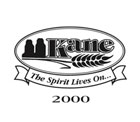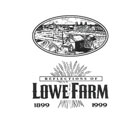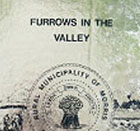 John Lowe was born February 20, 1824, in Warrington England, son of James Lowe and Anne Clarke. After studying in a private school, he set sail for Montreal in 1841, where on arriving found employment a fur trading – house. He soon discovered that he preferred literature to business and began a lifelong habit of reading for five or six hours every evening. In 1848, he put his interest to work as a reporter and assistant editor of the Montreal Gazette. In 1851, he left for Toronto to become editor of the British Colonist, the first daily newspaper published in Canada. On August 16, 1852, John Lowe married Almira Chamberlin in Frehligsburg, Lower Canada (Quebec). Within this marriage were born four children, two sons and two daughters.
John Lowe was born February 20, 1824, in Warrington England, son of James Lowe and Anne Clarke. After studying in a private school, he set sail for Montreal in 1841, where on arriving found employment a fur trading – house. He soon discovered that he preferred literature to business and began a lifelong habit of reading for five or six hours every evening. In 1848, he put his interest to work as a reporter and assistant editor of the Montreal Gazette. In 1851, he left for Toronto to become editor of the British Colonist, the first daily newspaper published in Canada. On August 16, 1852, John Lowe married Almira Chamberlin in Frehligsburg, Lower Canada (Quebec). Within this marriage were born four children, two sons and two daughters.
On November 1, 1853, Lowe along with his brother in-law, Brown Chamberlin, joined with a co-owner of the Gazette, James Moir Ferres, in buying out the other partner, John Milne. On April 1, 1854, Lowe and Chamberlin, with financing from Lowe’s father-in-law, bought out Ferres and became owners and co-editors of the paper.
The editors rapidly made changes. They moved into larger quarters, bought a new steam press and began publishing daily throughout the year. In 1855, they launched the Canadian Mail or Montreal Weekly Gazette for Europe. The Gazette flourished affording Lowe a comfortable living.
In May of 1867, Lowe and Chamberlin sold the Gazette to a new entity, the Montreal Printing and Publishing Company, which was in fact the principal investment of the firm Lowe and Chamberlin. On May 1, 1869, Montreal Printing and Publishing bought the Montreal Evening and Commercial Advertiser. By February of 1870, employees of Montreal Printing and Publishing had defrauded the company of at least $ 14,000.00. The telegraph was bankrupt and Lowe and Chamberlin were in financial ruins. At age 46, John Lowe was wiped out.
During his time in Montreal, Lowe made many influential friends including Christopher Dunkin, Federal Minister of Agriculture. Dunkin rescued Lowe by offering him a position as census staff officer. On July 9, 1870, John Lowe began his career in the civil service. On February 8, 1871, he was named temporary secretary of the Department of Agriculture, and on May 7, 1873, the appointment was made permanent. The job was favor, but for the civil service Lowe was an inspired choice. He enjoyed gardening, plant breeding and agriculture in general, and had also produced statistical publications. Moreover, Dunkin had especially wanted him to take responsibility for immigration, a job to which his writing, promotional and managerial skills were well suited. Population growth was essential to the financing of capital projects and to the development of the Dominion’s vast resources. Given a free hand, John Lowe threw his boundless energy into directing the web of immigration agents stationed in Canada and abroad. He developed
strategies to succeed in the competitive market for desirable immigrants, and negotiated special arrangements for their passage with his Montreal friends, Hugh and Andrew Allen, of the Allen Steamship Line. John Lowe’s enthusiasm for promoting Canada was redoubled by a visit on departmental business to the northwest and Manitoba in 1877. The company of his friend William Watson Ogilvie had shipped its first load of wheat from Manitoba that year. In January of 1878, Lowe would tell Ogilvie that the vast region was “destined immediately to become the great wheat growing region of the North American Continent….I saw…black Alluvium over 10 feet in thickness.” Lowe’s knowledge, liking for agriculture and entrepreneurial drive combined in his determination to get a piece of the Manitoba dealings.
By 1878, Lowe had persuaded his brother James, an affluent merchant in Manchester, England, to invest in Manitoba land and establish their sons on it to farm. He used his departmental contacts in Manitoba to acquire settlement land and Metis scrip until in 1879, he held 16 sections of land at the present day village of Lowe Farm and properties in town sites nearby. By 1881, James Lowe had invested over $50,000.00 in the scheme with almost no return. Damage caused by early frost, drought, drainage problems and fire was compounded by the evident unfitness of either of the Lowe boys for farming. Later attempts by Lowe to market a steam plough and sustain an irrigation and drainage company would also fail.
In the 1880’s, during the second Conservative administration of Sir John A. MacDonald, Lowe managed a tremendous campaign to attract immigrants, particularly farmers and farm laborers, for Manitoba. The number of immigrants peaked in 1883 at 133,600, and
immigration expenses reached over half a million dollars in 1884-85. However, depression, government restraint and the North West Rebellion of 1885 had precipitated a cutback in spending and immigration levels by 1890. In the midst of this decline Lowe’s responsibilities increased when on July 1, 1888, he was appointed Deputy Minister of Agriculture. John Lowe’s initiative effectively complimented the enterprise displayed by John Carling, Minister of Agriculture from 1885 until 1892.
The year 1895 was not a good one for John Lowe. In August 1895, while visiting Manitoba, the 71-year-old Lowe read in the Manitoba Morning Free Press that he was to be replaced as deputy. Outraged he appealed to political friends, but on December 1, 1895, John Lowe was superannuated (retired) and succeeded by William Bain Scarth, a political appointee. The death of his beloved wife, Almira, added a further burden in this grim year. He, none the less, remained vigorous; he continued to garden and write and tried to salvage his encumbered Manitoba farm. The functions of the Department of Agriculture, which included patent and trademark registration, immigration and agriculture seem disparate, but for John Lowe and his contemporaries they were closely related. Canada was engaged in a struggle with other colonies and the United States to attract labor. The Department viewed every cow as an advertisement as well as income for Canadian farmers. Statistics were used as a measure of the Dominion’s success and as ammunition in the immigration campaign. The volume of inventions measured the ingenuity of Canada’s entrepreneurial sector and provided new means to exploit resources. John Lowe himself, not content with a steady civil service job, took part in the risk and opportunity. His personal and professional life became almost indistinguishable in the 1880’s. Lowe Farm was meant to be not only an investment, but also a model farm and a testing ground for farming innovations. Its early progress was even documented in the Department’s Annual Report. John Lowe managed to outlive all of his children. At age 89 years he became ill and passed away on November 7, 1913, at his home in Ottawa. He was buried at the home of his friends the Chamberlins in Frehligsburg, Quebec.
John Lowe devoted all of his personal and professional resources to an integrated and national goal; the peopling and development of Canada, particularly Western Canada. He was responsible for the immigration process, acted as liaison between the Federal Government and the Russian delegations of Mennonites and outlined the responsibilities of the government toward Mennonite immigrants coming to Canada to settle. Unfortunately for John Lowe, the time was not ripe for the realization of his schemes, but he should be remembered for the talent, energy and unshakable belief in the future of Canada. The Village of Lowe Farm will always be proud to bear his name.
Submitted by Ralph Groening and Paul Joyal
Source: Dictionary of Canadian Biography




